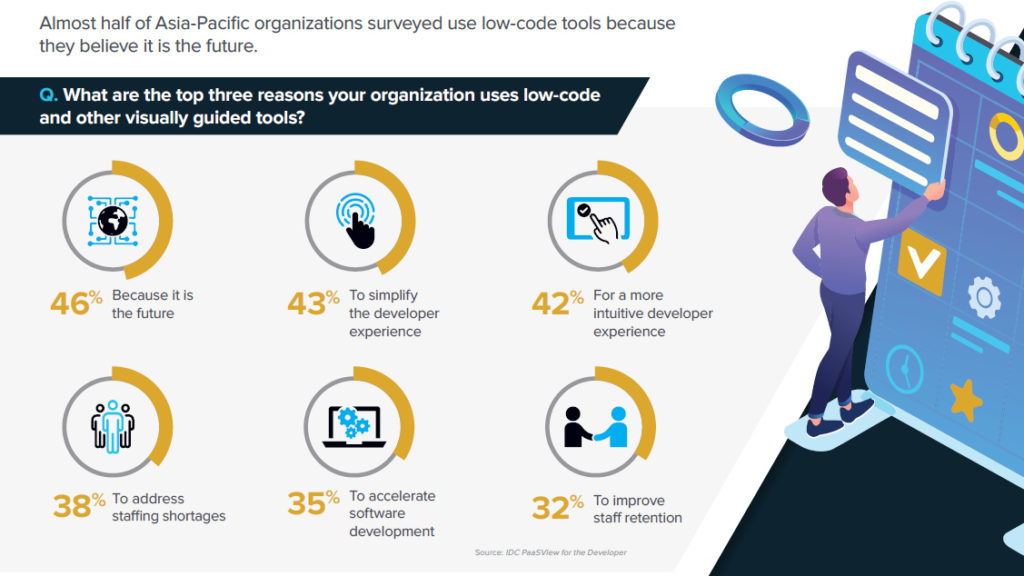With enterprises seeking always to operate with an agile mindset, adopting the low-code or no-code approach towards application development has been viewed as a possible solution for enterprises seeking faster time to market.

Other benefits touted by the low-code approach include increased scalability without incurring heavy costs and the ability for non-IT segments of the business to build applications to their liking.
The low code proposition appears to be an attractive one, particularly as organizations find it increasingly difficult to hire appropriately skilled developers.
But are there any downsides to going the low-code or no-code route? Is it a one size fits all approach or are there limited use cases? Can the visual programming interfaces offered by such an approach really make IT more accessible to the rest of the business?
Attendees at a roundtable discussion hosted by FutureCIO and OutSystems gathered to debate the pros and cons of adopting a low-code application development strategy.
Moving quickly
When security services provider Certis-Singapore needed to transform its 12 year-old paper-based quality management system into digital one, the company knew it needed to roll out the new system as quickly as possible in order to achieve greater efficiency and realize cost savings.
Adopting a low-code strategy allowed Certis-Singapore to deliver core features within five months, while the second phase of development took an additional five months, leading to the release of a mobile application to be used by its security officers, trainers and assessors. Full roll-out to Certis-Singapore’s 16,000 staff followed soon after.

“The term low-code is loosely used today; there is talk about how analytics, drag and drop and anything visual is low-code, but it really entails the ability to build apps quickly in order to respond to market changes,” said Leonard Tan, country manager for Singapore at OutSystems. “Innovators have to move, and they have to move faster.”
IT involvement
A VP for global treasury business transformation at a Singapore-based bank shared how his team already practices rapid application development and continues to observe heavy levels of IT engagement for most initiatives.
This VP questioned the need for IT to be involved all the time because certain departmental initiatives might be carried out more efficiently with the right resources available.
“It’s impossible to decouple yourself from IT, but there are ways one can build around relying too much on IT,” said Tan. “Many people think digital transformation is about investing in a technology and hoping it works, but it’s not just that.
“At the end of the day, it’s about having the right skillsets, both IT and non-IT. It’s called citizen development, allowing the business to build but with IT forming the fundamentals.”
Collaborative citizenship

According to Davin Lodge, head of IT for Europe, the Middle East and Asia-Pacific for Abbott, the biggest challenge in any digital transformation initiative lies not with the tools and technology, but the mindset of the people.
“To facilitate digital transformation, the vendor needs to help the people to understand the technology and change the working culture,” said Tan. “It’s sometimes best to have a third-party step in to explain how a certain way of building can translate into desired results.”
Starting small

David Tam, SVP, IT and CIO at Liberty Insurance, shared how his team adopted low-code four years ago while operating in the midst of core legacy systems. His team started off with a basic project that comprised the creation of insurance quotes, and it was a success.
“The POC was good, and it got done in a month. We started there and then, and our adoption of low-code expanded over the years,” said Tam. “We kept it mostly internal by choice and have built whole user experiences and workflows around it. Low-code has worked well for us, I would not say it’s two to three times faster than traditional application development but more like 30 – 40%, depending on use case.”
Tam added that having the platform hosted in the cloud alongside the entire DevOps pipeline has the added benefit of being fuss-free migration-wise.
“A major release upgrade took about three months, which I thought was pretty good,” said Tam.
According to Tan, the maintenance of any platform poses a challenge.
“The easiest way to talk about upgrading is not just about how easy it is to upgrade, but what the platform vendor can do to make the upgrade process easier, be it through a guided process, resources or partners,” said Tan. “Technology is only useful when people are receptive toward adopting it, and developer resistance is real. IT decision makers have to tackle the issues of training and enablement and at the end of the day, ensure there is a structure to facilitate a smooth upgrade.”
Complexity

Patrick Chia, director at Integrated Health Information Systems (IHIS), a government agency, emphasized the importance of evaluating the true capabilities of a low-code platform, particularly if it was to be used for a complex project.
“Systems are increasingly also expected to integrate with other systems and technologies, so we will need to strategically rationalise how low-code systems can gel, especially with those focusing on newer capabilities such as blockchain and artificial intelligence (AI),” said Chia.

For Benoit Nesme, director, IT PMO & enterprise transformation and data analytics at Essilor, low-code's value can be realised with regard to integration, while allowing for speed and agility gains.
“Low-code is moving into different segments of the IT stack, such as integration, visualization and even machine learning,” said Nesme.
When applying low-code to data analytics projects, IT teams should focus on going beyond dashboards, charts and reports to helping the organization make decisions, said Tan. “Any platform you buy must be part of the bigger plan and everything should be integrated on the backend, including the analytics platform.”
No magic bullet
No platform should operate as a silo, stated Tan, who added that low-code should also not be viewed as a magic bullet to solve all application development challenges.
“There are limitations,” said Tan, highlighting how low-code should never be used for high intensity applications such as mobile games. “You would not wish to put a layer on top of something like that, it doesn’t make fundamental sense and could compromise the performance of the engine.
“While low-code can be used for complex purposes, it is important to understand how technical that workflow will look like and how easy it will be to design and change.”
Legacy pains
A VP of IT at a local bank shared how his organization operates in a fairly legacy-heavy environment; and while the bank has been encouraged to hop onboard the private or hybrid cloud bandwagon by regulatory authorities, questions around readiness remain.
“Start with something that’s low-risk and low-investment, then see if you can go expand from there or go deeper,” advised Tan. “People always think low-code is more relevant to organizations with internal developers, but that’s not true. Operating in a hybrid environment requires a structure that allows transferability, so the same skillset can be transferred internally, and looking at visual elements is easier than looking at lines of code.”
This VP also emphasized the need for a DevOps strategy within the organization to ensure developers are operating on the same page.
“It’s a two-part play,” said Tan. “If the organization has DevOps today, that’s great, because it’s about understanding what it takes to govern the application development process. But if it doesn’t, whichever tool that is selected should still work because technology should ideally fill the gaps of what you do not have.”





